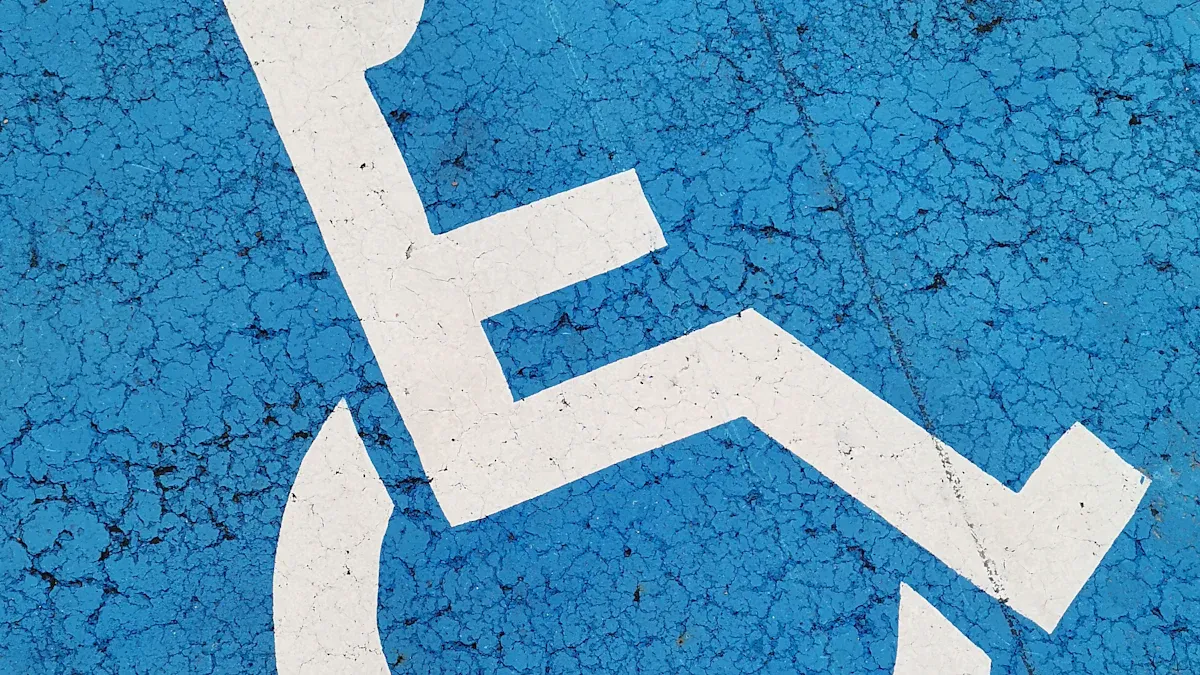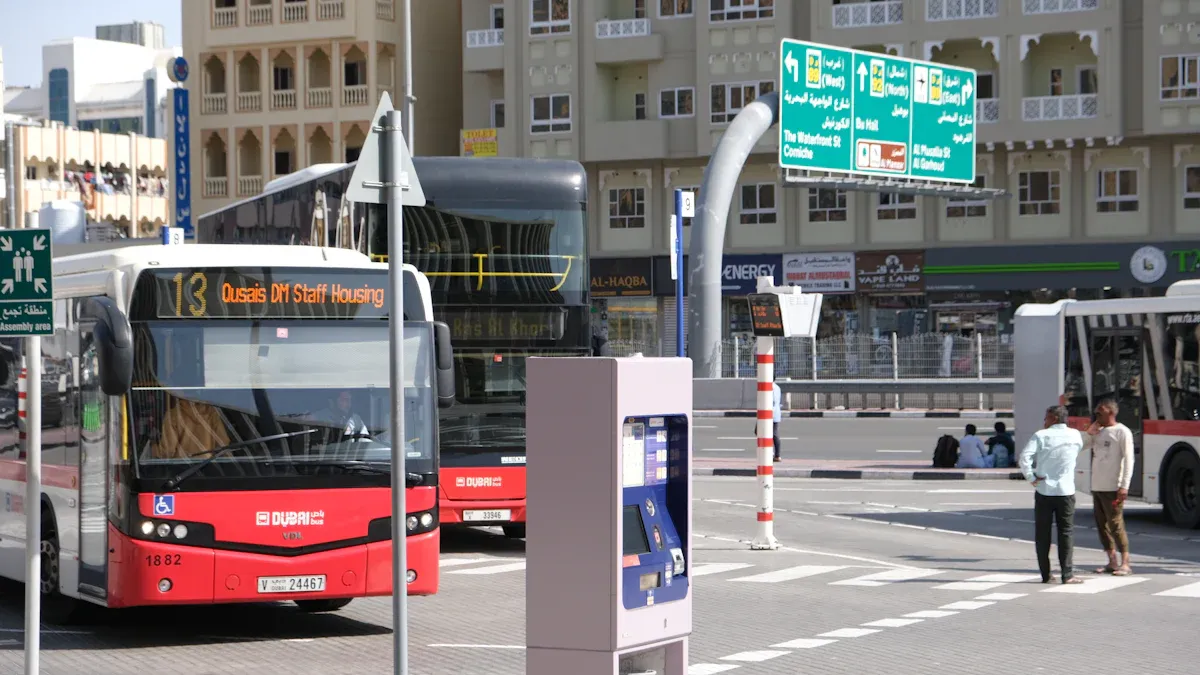Views: 0 Author: Site Editor Publish Time: 2025-05-27 Origin: Site









Imagine waiting at a bus stop, unsure of when the bus will arrive or if it’s delayed. Digital signage addresses this issue by providing real-time updates, keeping you informed and confident about your journey. Bus Stop Digital Signage enhances the experience by making information easily accessible to all, including individuals with disabilities. For example, Floor-stand Bus Stop Digital Signage is positioned at eye level for convenient access, while Built in Bus Stop Digital Signage seamlessly integrates into existing bus stop designs. By upgrading bus stops with these innovations, digital signage significantly improves public transportation for everyone.
Digital signs show live updates on bus times and delays. This helps people plan their trips easily and confidently.
Features like spoken announcements and bold visuals help everyone, including people with disabilities, get transit information quickly.
Screens with multiple languages make buses easier to use for people who don’t speak English well.
Touchscreen tools on digital signs help people find their way in crowded bus areas, making travel less stressful.
Keeping digital signs updated and working well is important. This makes sure passengers always get correct and timely information.
Digital signage at bus stops means electronic screens showing live updates. These screens share bus schedules, delays, and route changes. You always get the latest information. Unlike regular signs, digital ones can be updated remotely. This makes them fast and dependable. For example, if traffic delays a bus, the screen shows the new timing right away. This helps you plan your trip easily.
Digital signage improves commuting by boosting safety, comfort, and navigation.
Here’s what it offers:
Live updates about bus arrivals and delays.
Links to city traffic systems for accurate info.
Placed at transit hubs for easier connections.
Accessibility means everyone can use public transit, no matter their ability. It helps people reach jobs, schools, and doctors. Many rely on public transit as their only way to travel. Studies show older adults, people with disabilities, and low-income groups use public transit more often.
| Group | Public Transit Use Likelihood |
|---|---|
| Low Income | High |
| People of Color | High |
| Older Adults | High |
| People with Disabilities | High |
Accessible transit also encourages walking. Transit users walk about 33 minutes more daily than car users. This benefits both individuals and communities.
Old-style signs don’t meet everyone’s needs. They can’t show live updates, so delays or changes stay unknown. They lack audio or clear visuals for people with hearing or vision issues. They also don’t support multiple languages, making it hard for non-native speakers to understand.
Traditional signs are outdated, but digital signage offers modern, inclusive solutions.
Digital signage fixes these problems. It turns bus stops into welcoming spaces for all users.

Digital signage makes commuting easier by showing real-time bus updates. Imagine waiting at a bus stop, unsure when your bus will come. With digital screens, guessing is no longer needed. These screens show live arrival times, route changes, and delays.
At busy bus stations, real-time updates improve communication. Studies show travelers feel calmer and more confident with live updates. This feature removes the stress of waiting and helps you plan better. Whether you're going to school or work, digital signage keeps you informed.
Real-time updates help passengers stay informed and reduce travel stress.
Digital signage helps people who can't see well by using audio. These systems use text-to-speech to announce bus times, delays, and other details. If reading screens is hard, audio cues make sure you get the information you need.
Touchscreens with special feedback also help people with vision or mobility challenges. These tools make it easy to use the system, creating a more inclusive transit experience. By adding assistive technology, digital signage welcomes everyone.
Audio features let visually impaired users access transit info on their own.
Clear visuals are key for people who can't hear well. Digital signage uses bright colors and big text to make reading easier. Bold designs help you quickly find and understand the information.
Research suggests these tips for visual accessibility:
Consistent Placement: Signs should be in easy-to-find spots.
Large Printing: Text should be big enough to read from far away.
Optimum Use of Color and Brightness: Bright colors improve visibility outdoors.
Non-Glare Surfaces: Matte screens reduce glare for clearer views.
Proper Luminance: Good lighting keeps signs visible all day.
These features make digital signage helpful for hearing-impaired users, removing barriers to transit information.
High-contrast visuals make public transit easier for hearing-impaired individuals.
Digital screens help people in diverse areas by showing information in many languages. In places where people speak different languages, old signs often fail. Digital signage fixes this by sharing transit details in multiple languages so everyone can understand.
Multilingual signs make non-native speakers feel welcome. For example:
Signs in two languages in Chinatown, New York City, keep culture alive and attract more users.
Russian signs in Brighton Beach serve the Russian-speaking community and show their strength.
Spanish signs help Hispanic residents stay connected to their culture and feel included.
Greek signs assist older people with limited English, making public spaces easier to use.
Digital screens can even change languages based on who is nearby. This is helpful in areas with many cultures. By using multiple languages, digital signage makes sure no one feels left out and improves public transit for everyone.
Multilingual digital screens close language gaps and welcome all users.
Finding your way in a busy transit area can be hard, especially for people with disabilities or visitors. Digital screens make it easier by showing clear maps, directions, and tools to help you plan your trip.
Studies show how helpful these tools are. For example:
A study on the RouteNav app found that voice alerts helped blind users find bus stops and routes in busy areas.
Another study in Minneapolis found confusing signs and hard-to-find stops. It suggested adding maps with "You Are Here" labels and touchable signs for visually impaired people.
Digital screens use these ideas by offering interactive maps, voice directions, and touchable features. These tools make traveling simple and less stressful. Whether you ride the bus every day or are visiting for the first time, digital screens help you get where you need to go without trouble.
Wayfinding tools on digital screens make transit hubs easier to navigate.
Digital signage should be easy for everyone to use. This means designing it so people of all abilities can access the information. Problems like tiny fonts and bad color contrast make signs hard to read. To fix this, follow these tips:
Use big, clear fonts that are easy to see.
Make sure text and background colors stand out.
Choose screens that don’t reflect light or cause glare.
Place signs at eye level for wheelchair users and others.
These changes make signs more helpful for everyone. During COVID-19, many groups struggled with digital accessibility, showing why universal design matters. Fixing these issues creates a friendly space for all travelers.
Tip: Teach your team about universal design to improve accessibility.
Assistive tools make digital signage better for people with disabilities. Text-to-speech reads screen text aloud, helping those who can’t see well. Touchless systems, like voice commands, let people interact without touching the screen.
Here’s how these tools help:
Text-to-speech lets users hear bus info instead of reading it.
Touchscreens and voice commands work for different needs.
These features give users confidence and independence.
Adding assistive tools makes digital signage useful for everyone. These technologies make public transit easier and help people feel more independent.
Note: Using assistive tools shows you care about inclusivity.
Digital signage must follow rules like the Americans with Disabilities Act (ADA). The ADA, made in 1990, protects the rights of people with disabilities. It requires public signs to meet certain standards. Breaking these rules can lead to fines or other problems.
To follow ADA rules, you should:
Use screens that don’t reflect light or cause glare.
Make sure text and background colors have strong contrast.
Pick simple fonts that are easy for everyone to read.
Check your signs regularly and work with designers to meet these rules. ADA-compliant signs help people with disabilities move around easily. Following these rules makes public transit welcoming for all.
Reminder: Review your signs often to stay ADA-compliant and avoid penalties.
Digital signage at bus stops needs care to work well. Without it, screens might break or show wrong details. This can leave passengers confused. Regular checks and updates keep the system running smoothly.
Maintenance helps digital signage stay useful and trusted. Broken screens or old info can upset passengers. This is worse during delays or route changes. Fixing and updating signs often ensures they show correct, live updates. This makes public transit easier for everyone.
Tip: Taking care of your system makes it last longer and work better.
Here are ways to keep digital signage working well:
Proactive Monitoring: Fix problems like broken screens before they bother passengers.
Local Content Caching: Screens show saved info even if the network is down.
Remote Monitoring: Check and fix screens from far away to avoid downtime.
The table below explains these practices:
| Maintenance Practice | Benefit |
|---|---|
| Proactive Monitoring | Fixes broken screens fast, keeping passengers happy. |
| Local Content Caching | Shows saved info during network issues, staying reliable. |
| Remote Monitoring | Lets you fix problems from anywhere, keeping screens on. |
Updates are as important as maintenance. They add new features and improve the system. For example, updates can bring better visuals or tools for accessibility. They also protect against security risks, keeping the system safe.
Note: Old software can cause problems, so update it on time.
Reliable digital signage builds trust in public transit. Passengers feel confident when they see accurate schedules, delays, or directions. Regular care and updates show you value an inclusive and efficient transit system.
By focusing on these steps, you make digital signage helpful for all riders.

AI is changing how digital screens help commuters. It uses data like your travel habits to show updates you need. For example, if you often take the same bus, nearby screens will highlight its schedule first. This saves time and avoids confusion.
AI also makes transit easier for everyone. It can change text size or switch to audio based on your needs. These features help people with different abilities use public transportation without trouble.
AI makes transit info personal and easy to understand.
Digital screens are now part of smart city systems. They connect to IoT networks to share live updates. For example, bus stop screens can link to traffic systems to show accurate arrival times, even during delays.
Smart city projects are growing fast:
Digital screens are expanding because of smart city plans.
By July 2024, India’s Smart Cities Mission finished 7,202 of 8,018 projects.
Over 500 cities may use digital twin tech by 2025, saving $280 billion by 2030.
This connection improves commuting and helps cities grow sustainably.
Smart city tools make digital screens vital for modern transit.
New E-Ink and LED screens are improving outdoor digital signage. E-Ink uses less energy and works with solar power. Its paper-like look makes it easy to read in sunlight. It also keeps images without power, saving energy.
LED screens are bright and tough, perfect for busy areas. Both types let transit teams update info remotely. This means no manual updates, saving time and effort.
E-Ink and LED screens are eco-friendly, durable, and easy to use.
Touchless and voice-activated systems change how people use bus stop screens. These tools make public spaces cleaner, easier, and more welcoming for everyone. They remove the need to touch screens, helping people with disabilities and keeping areas hygienic.
Touchless systems use gestures and voice commands to work:
Gesture controls let you move your hand or body to use screens. This makes it simple and fun to interact.
Voice commands allow hands-free use, giving access to info without touching. This is great for people with vision problems or limited movement.
These tools stop germs from spreading, keeping public spaces safer.
Voice systems also make transit info easier to get. You can talk to the screen to hear bus times, routes, or directions. This removes the need to type, which can be hard for some people. These systems include everyone by offering a simple way to find transit details.
Touchless technology is becoming more important in public places. It improves how people use transit screens and makes spaces more inclusive. Whether you're at a busy station or a quiet stop, these systems help you get info quickly and confidently.
Tip: Touchless and voice systems aren’t just helpful—they make public transit safer and easier for all.
Digital signage makes bus stops easier and friendlier for everyone. It helps by showing live updates about bus times and delays. Clear visuals like maps and routes make finding your way simple. Emergency alerts keep passengers safe during unexpected events. These tools make traveling smoother and safer for all.
Using inclusive digital signage means public transit works for everyone. Transit leaders can focus on making transportation accessible to all. This creates a system that supports and welcomes every rider.
Tip: Adding accessible digital signage helps both riders and the community.
Digital signage gives live updates, sound features, and many languages. Unlike old signs, it changes with delays or route updates. This keeps your information correct and easy to access.
Tip: Digital signage makes traveling easier and less stressful for everyone.
Digital signage has tools like text-to-speech for blind users. It also uses bright visuals for people who can't hear well. Voice commands and touch-free systems make it simple for all to use.
Note: These features help everyone feel included and independent.
Yes, new digital signs are made with strong materials. They use E-Ink and LED screens to stay clear in sunlight, resist rain, and work in hot or cold weather.
Emoji: ️ Digital signage works in all weather, keeping you updated anytime.
Digital signage often uses energy-saving tech like solar-powered E-Ink screens. These use less power than old signs, helping the planet.
Tip: Eco-friendly signs support greener public transportation systems.
Digital signage shows emergency alerts and clear directions. These tools keep you informed during surprises, making travel safer for everyone.
Reminder: Having the right info during emergencies can save lives.